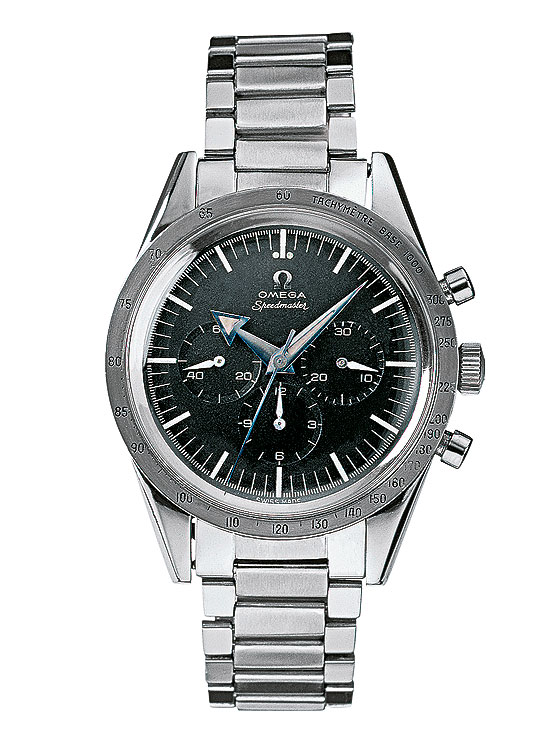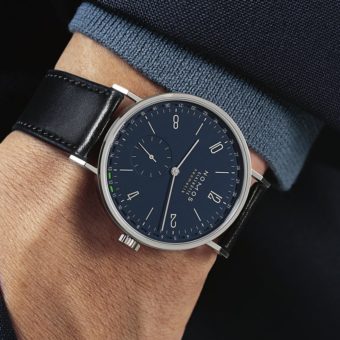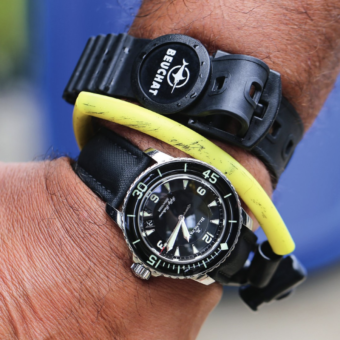When the Omega Speedmaster watch was introduced in 1957, no one imagined that it would later accompany a parade of space pioneers to the moon. The astronauts aboard Mercury spacecraft wore their own personal wristwatches. Some of these were Omega Speedmasters.
America’s first manned space missions began with Project Mercury, established on Oct. 7, 1958. In his address to Congress on May 25, 1961, President Kennedy urged the country to land a man on the moon and return him safely to Earth before the end of the decade. In pursuit of this goal, the National Aeronautics and Space Administration (NASA) announced a plan in December of that year to extend Project Mercury to develop a two-man spacecraft. This new program was named Gemini.
Astronaut Walter Schirra was wearing his own Speedmaster when he and his Sigma 7 Mercury spacecraft orbited the Earth six times on Oct. 3, 1962, a flight lasting 9 hours and 15 minutes. NASA decided to make astronauts’ wristwatches part of their equipment for Project Gemini and for the subsequent Apollo program, and thus for the moon landing. The agency commissioned James H. Ragan, a NASA aerospace engineer and flight hardware expert, to write a list of specs, test potential watches and purchase the winning models. The watch would have to be a chronograph, and an official call for candidates was issued. In addition to Omega, other entrants were Longines, Wittnauer and Rolex. All models were tested under zero gravity, extreme pressure variations, bone-jarring vibrations, and temperatures ranging from -18 to +93 degrees Celsius. The watches were also tested by astronauts aboard a Gemini space flight.

The Speedmaster outperformed all the other watches in both test series. The watch was officially designated as “flight-qualified by NASA for all manned space missions” on March 1, 1965. NASA bought an initial group of 15 to 20 Speedmaster watches from Omega. Unlike almost all other Apollo equipment, the watch was not manufactured for use specifically by NASA or for use in space but was available in retail outlets in the U.S. The first Speedmaster models flew into space three weeks later on the wrists of astronauts Virgil “Gus” Grissom and John Young as official equipment aboard Gemini 3. This was the first official trip for the chronograph although it had already flown in space twice on Project Mercury missions.

The real test for the Speedmaster came on June 3, 1965, during the Gemini 4 mission, when astronaut Edward H. White wore the chronograph over the sleeve of his spacesuit for a spacewalk. The environment in outer space is as harsh as any a watch will encounter anywhere. Near-vacuum conditions and extreme temperatures prevail. The temperature on the side of the ship exposed to the sun climbs to about 100 C and plummets on the other side to approximately –100 C. In anticipation of these rigors, Omega developed prototypes with red anodized aluminum cases for protection from extreme temperature variations and dials coated with zinc oxide to provide the highest resistance to solar radiation. But these prototypes turned out to be unnecessary because the Speedmaster withstood the extreme temperatures without any modifications.
To read the rest of this story, plus more about the Omega Moonwatch, order the WatchTime E-Special: Omega Speedmaster.
This article was originally published in 2012 and has been updated.







I,m looking for one of these with the Snoopy character on the dial face if anyone out there! Has one to sell.
Wasn’t the “tuning fork” movement made under license from Bulova? I believe I remember seeing pictures of the movement with both names engraved upon it.
Also, if another source is correct, after the “made in America challenge,” didn’t Omega have the cases made in the U.S. to help settle the matter, or is that just an “urban legend”?
Great bit of history, thanks!
Thanks for your add-on, Colin.
Do you’ll have an image of ‘ turning- fork mechanism movement’… Addon to the above Informative article back 1969 when Omega was marketing First watch to land on the moon they had intially mentioned Neil Armstrong first man to walk on the moon with Speedmaster, later when NASA revealed the malfunctions advertisement campaign was edited to Mr. Edwin buzz ; unfortunately 2nd man walk the moon with his Omega !!!!!